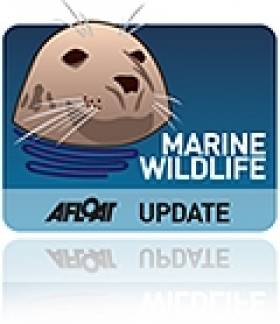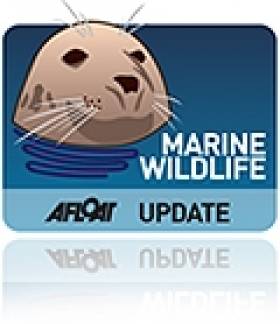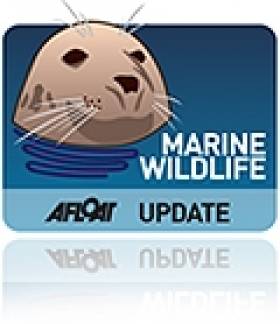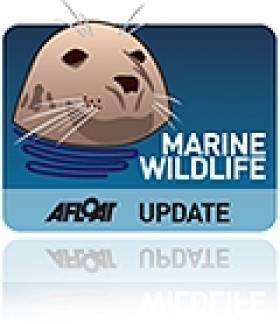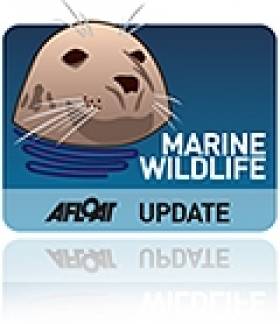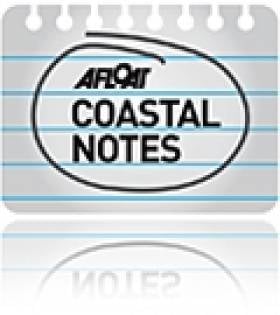Displaying items by tag: Whales
Rare Whale Sightings Off Continental Shelf
#RareWhale - A recent trip to the edge of the continental shelf by the Irish Whale and Dolphin Group's (IWDG) research vessel Celtic Mist resulted in an encounters with one of the ocean's most rarely seen creatures.
Surveying an area in the Porcupine Basin, just north of the Goban Spur, researchers sighted three beaked whales passing within 50m of the vessel on the morning of 4 September.
"These three animals were almost certainly True’s beaked whales but from the photos cannot be distinguished from Gervais beaked whales," writes the IWDG's Patrick Lyne.
"These animals, first seen alive in 1995 and with only two confirmed sightings in the wild, must be some of the most rarely seen animals on the planet. Mostly they are only known from strandings of already dead animals."
The following day, the team sighted Northern bottlenose whales, one of the more abundant species of beaked whale but one that's an infrequent visitor to Irish waters.
The IWDG has more on the story, including photos, HERE.
New Research Says Sonar Sends Whales Scurrying
#MarineWildlife - The Guardian reports on new research which proves that military sonar has a direct effect on the behaviour of whales in our oceans - even leading to mass strandings.
The studies, part funded by the US Navy, found that beaked whales where particularly sensitive to sonar - and that even blue whales, the largest animals on earth, were distracted from feeding by the subsurface noise.
It's long been feared that the use of sonar is to blame for unusual behaviour among whales, who navigate and communicate with each other over long distances using sound.
As previously reported on Afloat.ie, the Irish Whale and Dolphin Group (IWDG) identified sonar activity by Royal Navy submarines as a possible cause of a the mass stranding of pilot whales in Donegal in November 2010, in which as many as 35 whales died.
Now for the first time, sonar has been proven to affect behaviour of cetaceans to a detrimental degree, confirming for many a connection between the use of sonar technology and recordings of whale and dolphin strandings identified since the 1950s. The Guardian has much more on the story HERE.
In more positive whale-related news, the IWDG reports that its next Cape Clear summer whalewatching course over the weekend of 26-28 July is "filling up nicely".
Places are still available but as it coincides with the tourism high season in West Cork, anyone interested is advised to book sooner than later to ensure they have someone to stay nearby.
The most recent weekend course over the June bank holiday witnessed numerous harbour porpoises and common dolphins, but its hoped the elusive whales will make an appearance next time round!
Cillian Murphy Lands Plum Role In Maritime Movie
#AtTheMovies - The Irish Independent reports that Irish actor Cillian Murphy has signed on to appear in new maritime adventure film The Heart Of The Sea.
Ron Howard is directing the adaption of the Nathaniel Philbrick book, which follows the fortunes of the whale ship Essex and its encounter with an angry sperm whale in the South Atlantic.
Murphy - who previously narrated the award-winning surfing documentary Waveriders among his prestigious blockbuster credits - will play the ship's second mate.
The film also features Thor star Chris Hemsworth, and is set to begin shooting in the UK this September.
Whale Rescued In Meath Stranding Drama
#MarineWildlife - Skerries RNLI joined a number of groups in assisting a beached whale back out to sea at Gormanston in Co Meath earlier today (Thursday 20 June).
The volunteer lifeboat crew launched their inshore lifeboat shortly after 10am following reports from the Irish Whale and Dolphin Group (IWDG) that a 25ft pilot whale had beached in the area.
The lifeboat helmed by Joe May, and with crew members Emma Wilson, AJ Hughes and Laura Boylan onboard, made its way to the scene where May got into the sea and helped manoeuvre the whale back into deeper water.
Skerries RNLI then shadowed the whale guiding it out to sea, preventing it from turning back to shore by positioning the boat in its way. The lifeboat did this for about 25 minutes until the mammal was well clear of the shore.
Other agencies on scene included Skerries coastguard, the Defence Forces based at Gormanston, the IWDG, Boyne Fishermen’s Rescue and Irish Coast Guard helicopter Rescue 116.
Meanwhile, RTÉ News reports that a second whale was found dead on the beach near Mornington, north of Bettystown.
Despite initial fears that the whale was the same one rescued in the morning, it was later determined to be a different creature.
#MarineWildlife - A gray whale has been sighted many thousands of miles from its usual Pacific swimming grounds in the South Atlantic.
As Pádraig Whooley writes on the Irish Whale and Dolphin Group (IWDG) website, the whale was spotted in the last week in Walvis Bay, Namibia - only the second ever confirmed sighting of the marine species in the Atlantic Ocean, and the first south of the equator, since records began.
Previously a solitary gray whale was tracked in the Mediterranean in May 2010 from the coast of Israel to Barcelona in north-eastern Spain.
That was the first time a gray whale had been seen anywhere east of the Pacific Ocean following the presumed extinction of the Atlantic gray whale in the 17th century.
Whooley calls the latest sighting "a fascinating discovery" and says it "points strongly towards a dramatic shift in distribution facilitated by climate change.
"This is a timely reminder that we should never assume to know what species occur in our local waters, especially when this species seems to have literally come back from the dead."
'Unusual' Dolphin, Whale Strandings In Northwest
#MarineWildlife - Seven dolphins and two beaked whales have stranded on beaches in the northwest in events described as "unusual" by the Irish Whale and Dolphin Group (IWDG).
On the Mullet Peninsula, a group of seven common dolphins - comprising five adults and two juveniles - live stranded at Tarmon Beach on Sunday 12 May.
Though initial attempts to refloat them were successful, one of the juveniles was later found dead and the other was euthanised due to poor health.
Meanwhile in Donegal, the fresh carcass of a female True's or Sowerby's beaked whale was found on Sunday evening on Five Fingers Stand at Inishowen - some days after a reported live stranding of a Sowerby's beaked whale on the Welsh coast.
The Inishowen stranding was followed yesterday 14 May by the discovery of a dead beaked whale calf at Trawbreaga Bay, in what is believed to be a connected stranding.
Samples of the adult female were taken in order to confirm the species, either of which would mark a rare cetacean record for Ireland - the first since 2009.
#DolphinExhibition - Balbriggan Maritime Museum has opened a new public display in Balbriggan Tourist Office on Quay Street near Balbriggan Harbour.
On show is a Whale and Dolphin Exhibition, bones, models and general information to celebrate the biodiversity of sea mammals off the coast. This follows the previous popular 'Cannon Balls Exhibition'.
Appropriately, 'Water & Biodiversity' is the theme of the 2013 International Day for Biological Diversity which falls on Wednesday, 22nd May.
Balbriggan Maritime Museum volunteers have assembled bones from many sea animals, such as a vertebra from a Fin Whale, the second largest whale in the world growing to 88ft in length. No wonder this bone is too heavy for one person to lift!
The Humpback Whale model, in real life, is about half the length of a Fin Whale and weighs only 40 tonnes! Even so, Humpback Whales, which are seen in the Irish Sea, would be too big to fit into Balbriggan Courthouse!
Smaller skulls from Common Dolphin, Pilot Whale and Grey Seal, as well as a Minke Whale jawbone can also be examined during May when this Whale and Dolphin Exhibition will be on display from Tuesday to Sunday when the Balbriggan Tourist Office is open.
#marinewildlife – A team of Irish scientists has just published the first information on the diet of fin and humpback whales in Ireland for one hundred years.
Until now, the only information on the diet of large baleen whales such as fin, humpback and minke whales in Irish waters, was gathered in 1913 by a Mr Burfield in Belmullet, Co Mayo where two whaling stations were operated by a Norwegian enterprise at the time. These whaling stations caught mostly fin whales as they migrated along the shelf edge close to Co. Mayo. Two new studies published in Marine Ecology Progress Series and Marine Mammal Science used stable isotopes and mixed modelling to reveal the diet of fin and humpback whales in Ireland.
Following regular sightings of fin, humpback and minke whales close to shore over the last 10-15 years there has been a resurgence of interest in whales in Irish waters. From June to February between Slea Head, Co. Kerry and Hook Head, Co. Wexford, fin and humpback whales appear to follow the seasonal movements of sprat and herring as they congregate inshore to spawn. The Irish Whale and Dolphin Group (IWDG), Galway-Mayo Institute of Technology and the Marine Institute collaborated on a project to determine what these whales were feeding on – essential information if we are to adopt a more sustainable 'ecosystem approach' to managing our fisheries. This ecosystem approach recognises that there are predators, other than humans in the marine ecosystem, which are entitled to marine resources and that these are an integral link in a complex food web which needs to be kept intact for the health of our oceans and for the benefit of our coastal communities.
Studying the diet of large whales is challenging. They cover vast distances and dive for up to 15 minutes at a time, and despite their huge size (fin whales up to 21m) they are difficult to follow and observe in the rough seas around Ireland. When they die and strand, it is difficult to obtain stomach samples before the carcase heats up with decay and quickly rots. At any rate, most of the stomach samples from dead whales are empty as these individuals tend to be sick. An alternative approach to investigating their diet was needed and this study used stable isotope analysis. The field of stable isotope analysis is rapidly becoming an essential tool for all scientists to trace food-webs and to follow ecosystem nutrient cycling in marine systems. In a novel way, this enables researchers infer information on their origins and dietary influences.
Skin samples were collected from fin and humpback whales using biopsy darts fired from a cross-bow. For the past decade, the IWDG Large Whale survey team has been conducting this field work during autumn and winter when the whales are close inshore in large numbers. They used local whale-watching boats or the IWDG rigid-hulled inflatable boat Muc Mhara to get close enough to the whales to dart them and photograph unique markings to help identify individual whales. This work was licensed by the National Parks and Wildlife Service. Chemical tracers, in this case stable carbon and nitrogen isotopes, in the skin of the whales were analysed. These same chemical signatures were measured in samples from sprat, herring and various krill species of different age classes, collected during annual fisheries surveys from the Marine Institute's R.V. Celtic Explorer. By matching the best fitting stable isotope signatures, the researchers were able to calculate what proportion of each prey species the whales were consuming.
The results showed that fin whales in Irish waters have a diet comprising 50% krill and 50% young sprat and herring. Throughout most of their range in European waters, fin whales feed almost exclusively on krill, so the Irish whales are unusual in that they rely heavily on small fish. Humpback whales seem to prefer sprat and herring when feeding in Irish waters and their diet comprised less than 30% krill. The research team also examined the long term diet of whales by analysing stable isotope values of baleen plates, which are flat sheets of fingernail-like tissue in the mouths of some large whales, used to filter food from the seawater. By using baleen plates stored in museums in Ireland and the UK the study examined changes in diet over the last 100 years. The main finding was that the long term diets of minke, fin and humpback whales are quite different from each other. This result was somewhat unexpected as these species are often seen feeding in close proximity to each other.
These results which have recently been published in the international science journals: Marine Mammal Science and Marine Ecology Progress Series, arise from a three year PhD project at the Galway-Mayo Institute of Technology (GMIT) and funded by the Irish Research Council.
Dr Conor Ryan said," We now have clear evidence that sprat and herring are important species supporting whales in Irish waters, and we must manage our fisheries with this in mind. We are very worried that sprat is being fished with an open quota, despite a huge gap in our knowledge about the life history of this important species in the Celtic Sea".
Dr Simon Berrow, lecturer in Marine Science at Galway-Mayo Institute of Technology (GMIT), Executive Officer of the IWDG, and member of the Celtic Sea Herring Management Advisory Committee added, "This data will be incorporated into the new Environmental Management Plan commissioned by the Celtic Sea Herring Management Advisory Committee which is essential for the proper management of these fisheries and ensuring this fishery is compliant with Marine stewardship Council requirements. Whale-watching is growing in Ireland and has the potential to expand much more if we manage these fish stocks for both fishers and whales and dolphins, which will bring further benefits to coastal communities".
Dr Brendan McHugh a chemist at the Marine Environment and Food Safety Services in the Marine Institute said, "Collaborative studies like this one between biologists and chemists are key to developing a greater understanding of ecosystem linkages and their impacts."
Whale & Dolphin Group To Retrace Journalist's Whaling Voyage
#MarineWildlife - An upcoming research cruise by the Irish Whale and Dolphin Group (IWDG) is set to follow the path of a famous whaling voyage embarked on by an Irish Times journalist more than 100 years ago.
The paper reports on the pending mission by the marine wildlife charity's Celtic Mist research vessel that will retrace the movements of Crawford Hartnell from the site of what was then a Norwegian whaling station in the Inishkea Islands off the Mullet Peninsula in Mayo to a point 160km west where Hartnell report the harpooning of two whales.
Hartnell's accounts of his whaling adventure are remembered today for their blood-soaked vividness - but the IWDG's advances are altogether more friendly.
Rather than harpoon their quarry, the researchers on board the Celtic Mist will be on the lookout for baleen and beaked whales to count - and will also be teaching IWDG members how to identify species, how to carry out sea-bound surveys and how to use hydrophones to identify cetaceans by the sounds they make beneath the waves.
The Irish Times has much more on the story HERE.
Windy City Premiere For Short Film Shot in West Cork
#CoastalNotes - A new Irish short film shot on location on the south-west coast will have its premiere in Chicago this weekend, as the Southern Star reports.
The Blow-Ins is a 15-minute adventure comedy that was shot in Courtmacsherry, Kilbrittain and other picturesque coastal spots in West Cork.
It fictionalises story of the notorious Kilbrittain whale that washed ashore in 2009, as a family of 'blow-ins' from the capital attempt to rescue the stranded cetacean.
Written and directed by CJ Scuffins for Story Factory, The Blow-Ins will premiere at the 14th Chicago Irish Film Festival from Friday 1 March after its recent acclaim at the recent Corona Cork Film Festival.
The Southern Star has more on the story HERE.
































